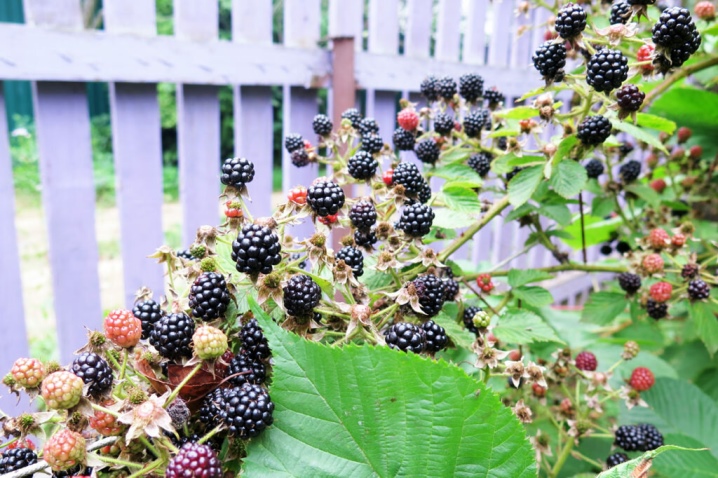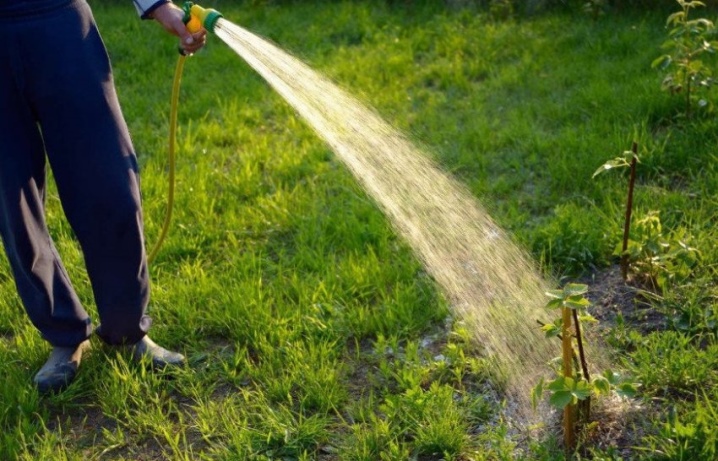Features of growing a thornless blackberry

Blackberries are one of those crops that you want to see on your site. But caring for it can be difficult due to the large number of thorny thorns that can cling to clothing and injure the skin. If you do not want to constantly struggle with thickets, it is recommended to choose a thornless variety. These varieties are perfect for beginner gardeners.

Peculiarities
The forest blackberry is cultivated on a huge scale today. This culture is completely domesticated, and breeders continue to develop new resistant varieties from year to year. Blackberries grow in the form of a bush, their foliage is green, small in size. Flowering takes place in June, while the plant is covered with small white or white-pink flowers. Ripe berries come in different shades: dark blue, red, purple.
Sometimes it happens that the whole bush is a multi-colored palette. That is why the studless blackberry is often used for garden decoration.
Growing a garden climbing culture has its advantages:
- the yield is an order of magnitude higher than that of varieties with thorns;
- berries can be easily picked;
- the culture resists frost perfectly;
- the fruits are tasty and full of vitamins.

There are also some negative points:
- uneven maturation;
- susceptibility to pest attacks;
- no pollination occurs in case of rain.
Those who plan to start an openwork beauty on the site should know that there are many varieties of such a culture. The choice should be made based on the region of residence. So, for the Moscow region, you can choose the following varieties:
- Apaches;
- Chester;
- Black Satin;
- Thornfree;
- Black Diamond.


Suitable for the middle lane:
- Doyle;
- Ruben;
- Loch Tei;
- Natchez;
- Columbia Start.

The best winter-hardy varieties:
- Polar;
- "Oregon";
- "Agavam";
- Chester Thornless;
- "Crush".

Landing nuances
Planting features depend on how winter-hardy the variety is and in which region it is to be grown. In the south of the country, in the Moscow region, as well as in the middle lane, it is customary to plant blackberries in the fall, about 30 days before the first frost. It is important to be in time before the temperature drops below -2 degrees. In the Siberian District, as well as in the Urals, it is better to plant the culture in the spring, until the air warms up to +15 degrees. This will allow the blackberry to quickly adapt and grow.
The area where the forest beauty will grow must be filled with light. The more it is, the sweeter the harvest will be. The slightest shading is unacceptable. The soil should also be chosen correctly. It should be loam with humus in the composition. Sandstone will prevent plants from thriving. Digging is carried out in advance, depending on the variety. If the planting is in the spring, preparation is carried out in the fall, if in the fall, then in the spring. The site is cleared of debris, dug, organic matter, wood ash is introduced.
For planting, seedlings are recommended at the age of 1 year. They should have well-developed roots about 10 centimeters long. Before planting, the roots are lightly pruned. Pits are dug at a distance of a meter from each other. Their diameter will be 50 cm. The climbing variety is planted in a slightly different way. Here the bushes should be 4 meters apart. Humus, superphosphate and potassium are laid in the pits (1 bucket, 100 and 35 grams, respectively). Humus is placed at the bottom, covered with a layer of earth. The depth of the fossa is about 80 cm.
The root collar is not deeply buried, about 1 centimeter. After planting, the plant is watered, the dose is 5 liters.

Care
Growing wild blackberries is not too difficult if properly cared for. You need to pay attention to the nuances of agricultural technology listed below.
Pruning
The fruits of the thornless blackberry will grow on last year's shoots, this must always be taken into account when pruning. Remember that the shoots are very long in length, so the installation of trellises will become a must. The supports are placed approximately 3 meters apart. Next, the wire is stretched. All of these actions will greatly help make pruning easier and more productive.
As for the procedure itself, it is carried out in a certain way.
- Sanitary pruning should be carried out in the spring. Examine the bushes, remove branches and shoots that are frozen, as well as those that have become dry. This procedure will speed up maturation. It should be carried out before sap flow.
- Plants that are on the site for the first year, in addition to spring, are pruned in July. In the spring, they are engaged in side shoots: they should be shortened by 7 cm. In the summer, branches more than 50 cm long are found. They are cut off by no more than 10 cm. Additionally, you can pinch the tops. The maximum number of lateral processes is 7–8. This will allow the bush to form correctly.
- The most important thing is autumn pruning.... This formation is carried out in the fall, after the end of fruiting. You need to remove almost everything, as a rule, gardeners leave about 8 shoots this year. They should be cut by 1/3. This procedure will allow the culture to winter well.

Watering
Blackberry is a fairly drought-resistant crop, and its powerful roots allow it to extract water from the deep layers of the earth. Therefore, frequent watering is not needed. It is quite enough to water 3-4 times per season, but abundantly. The plant especially needs water when it begins to bloom and bear fruit. The last watering will be water-charging, designed for comfortable wintering. It is carried out after the last harvest.
If there are a lot of bushes, watering them by hand can be difficult. The optimal solution is the grooves that are dug along the rows. Another option is drip irrigation.
Any of the types is carried out in the evening, when the sun goes away. Otherwise, moisture will evaporate from the soil. Do not pour water on the leaves either.

Top dressing
Young seedlings will not require fertilization, since what the gardener laid when planting is enough for them. Further, it is recommended to use a scheme consisting of 3 main stages:
- mullein / chicken / ammonium nitrate solution in liquid form - one of these fertilizers is chosen for the spring;
- wood ash it is used in the summer, during the period of active maturation;
- superphosphate, as well as again wood ash will come in handy in the fall.
In addition, one should not forget about complex mineral compositions. However, most gardeners use them only when the plant has experienced stress: it hurt, transplanted, etc.

Preparing for winter
The thornless blackberry necessarily requires shelter for the winter. To prevent the plant from freezing, it must be removed from the trellis, and then fixed on the ground. It is customary to cover the culture from above with special materials, straw or spruce branches. As soon as snow appears, small snowdrifts are built.
You cannot take leaves from other bushes, trees, and even from the blackberry itself, because fungal pathogens are often found in it.

Transfer
It is required for plant rejuvenation. On the same plot, it successfully yields a harvest for 10 years, then it must be transplanted, extending the life of the culture for the same period. Soil and site preparation will be the same as for planting. It is important to take into account the winter hardiness of the culture. If the blackberry was originally planted in the fall, then a transplant should be done at the same time.
The procedure is not difficult, but it should be done carefully. It is best to transplant the plant directly with an earthen clod, then it will have less stress from changing locations. Difficulties may arise with the main root as it is thick and goes deep into the ground.In most cases, the main root is simply chopped off. The plant is transferred to a new place, the roots are well straightened, and lowered into the hole. Sprinkle with earth and watered. The last step is to lay the mulch.

Reproduction
In order not to buy new seedlings in nurseries every year, blackberries can be propagated independently. Let's describe the most popular techniques.
Cuttings
This is the most demanded method. Cuttings are taken, which are approximately 7 cm long and 1 cm thick. Then they are folded into a bag and placed in the refrigerator. In the last month of winter, cuttings are planted in a container and grown until April. Then they take it out into the street, into the open ground. The disadvantage of this method is that thorns will appear on the blackberry.
Therefore, there is another option for how to cut a plant. Shoots that are already lignified should be cut into pieces 40 centimeters long in the second month of autumn. They are buried in the ground at a shallow depth. In April, it is worth digging out the cuttings, cutting off the tips. Instances are laid out from each other at a distance of a quarter of a meter, sprinkled with soil and covered. Next, you need to water the plants and loosen the ground.
When foliage appears, they are divided into seedlings and planted in separate containers. Fortified cuttings are rooted in open ground.

Digging in
The procedure takes place in August. You need apical layers, which should be tilted towards the soil. To make the plant grow faster, you can cut it in several places. The layering is attached to the soil, covered with soil, but so that the top looks out of the ground. The layering is mulched and do not forget to water. In the spring, the mature plant is separated from the main bush.

Root processes
The method is suitable for plants that are already three years old. The offspring should be separated from the main bush with a shovel, and then rooted in a new place. This should be done in the spring.
The seedless blackberry is almost never grown from seeds. It is a long and difficult process and the germination rate is extremely low.














Thanks. Blackberries made me happy this year - they bore a lot. Delicious jam. But what to do with it in the fall, I don't know. Everything is clearly written in your article. Thanks a lot.
Thanks a lot. It is written very clearly.
The comment was sent successfully.